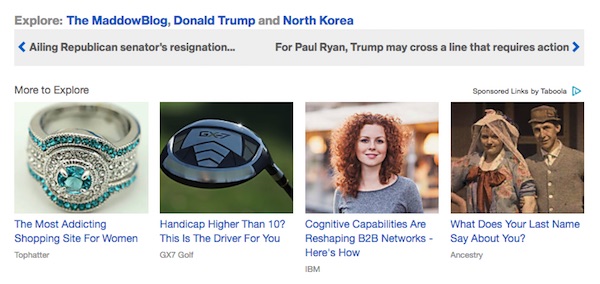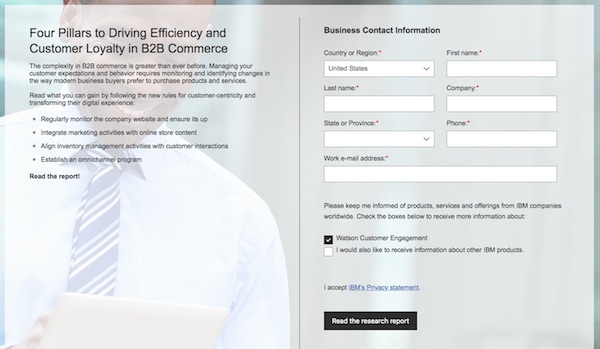Why is IBM hiding the strikingly attractive analysts on its business-to-business team?
IBM is using good-looking women to get you interested in their business-to-business services. Are you cool with that?
I was reading an article on MSNBC about Donald Trump having an imaginary phone call with the North Koreans when I saw this ad panel at the bottom of it:

I was immediately intrigued. Cognitive capabilities in B2B — that is an awesome idea. But I had to know . . . who was that young woman with the curly red hair? I instinctively knew her name was Colleen. And I know a lot of B2B analysts, but Colleen was new on the scene. IBM had clearly poached her right out of Harvard or Stanford. One click and I’d get to see her B2B insights. But no. . .
She was nowhere to be found. Instead, I got an offer to download an IDC report in exchange for my email.

Ah. So Colleen worked for IDC. I eagerly downloaded the report, but somehow, IDC was giving two guys named Simon Ellis and John Santagate credit for her work.
So who was she? While her visibility in B2B is low, she apparently has a sidelight advising people on hair-care products.

This was proving to be harder than I thought. So I went back to the original article, but Colleen was gone. She’d been replaced by somebody new.

More B2B analysis from another attractive woman. You could tell this one was smart because of the short, stylish haircut and the head tilt. I had a feeling her name was Catherine, and that she was Colleen’s boss. But was she trying to take credit for Colleen’s hard work? Another click should reveal the truth.

Catherine was gone, replaced by a shadowy African-American man in tie. Once again, IBM was pulling a bait and switch. But a thorough search revealed that Catherine was actually a woman named Samia Laouedj, writing a blog posts for an agency in France called Findeur.

(I know the photo is small, but I’ve clicked on the image and it is absolutely the same woman.)
I had no idea that IBM’s network of contributors ranged so widely. And yet, they all seem to have something in common . . .
Using “booth babes” was reprehensible in the 80s. It still is.
In the 80’s, a common strategy for attracting attention to your trade show booth was to hire attractive young women to stand in front of it. They were called “booth babes.” And there were even agencies that would supply them to you.
Booth babes are no longer in fashion, thankfully. But in the Web era, apparently IBM’s B2B marketing team still thinks it’s fine to use stock photos of attractive women in ads to get you interested in their products.
I’m sure that these ads tested well. Most of IBM’s buyers are probably men. And like me, those men wonder about these women and what they have to say about B2B marketing. They might get lots of clicks. They might even get lots of clicks from people who have nothing to do with B2B, marketing technology, or anything . . . they just like curly red hair or nicely coiffed brunettes.
But if you’re a B2B buyer who is a woman, a gay man, or, for that matter, a man who makes decisions on a basis other that the attractiveness of the women in the ad — you’re not the target of this ad. Does that bother you?
If you’re a woman working for IBM — or a man there who supports actually judging women based on their accomplishments or intelligence — do these ads bother you? If you’re IBM CEO Ginni Rometty, is this the way you want to feature women in your ads . . . as clickbait?
I thought we were done with booth babes. It will happen eventually. I’m still waiting.
As a lesbian woman, I wouldn’t mind this ad at all… As a hetero woman who worked many years in IT and who was competent at what she did, I didn’t mind the extra attention I got many times as the only (or one of the only) women in the room. It allowed me an advantage that equally competent males at my level did not receive. It was much easier for me to capture people’s attention. (Of course it was also up to me to have something of value to say – it wasn’t a free ride.)
Looks are important and most successful women have learned to use their looks to their advantage (including Ginni Rometty – she looks pretty put together). I think it is hypocritical for women to complain about male attention on the one hand, yet use it to their advantage on the other.
I’m also curious if you would have objected to a stock photo of a nicely-coiffed young professional man who had no personal relation to the content. Why didn’t the shadowy African American man bother you? Or the other attractive white guy smiling behind his laptop? Did these stock photo men have anything to do with these ads? IBM might even credibly be able to make an argument that they were using images of professional females in an effort to “feminize” and diversify their advertising. (Although I suspect that you are right that this is clickbait… Just another example that sex sells.)
What happens to the unattractive women? If a man is overweight or bald, he still gets the same level of respect as any other man. Much harder for a woman.
Regarding the shadowy African American man, the only thing that bothered me is that he had nothing to do with the woman in the ad . . . or for that matter, the content.
If IBM wanted to “feminize” and diversify their advertising, well, I’d like to see images of actual IBM data scientists, marketing strategists, or for that matter, their CEO. Not stock photos chose to appeal to men.
Many studies have shown that the more attractive a man is, the more advantages he has in business. (Height seems to really be a factor for men.) Much as we’d like to think otherwise, we are a visual species and looks do matter. Looks aren’t everything, though. An ugly woman who is very smart has every ability to get ahead, she just won’t have the advantage of looks. You don’t need to look any further on that than Hillary Clinton. 😉
We all have our advantages and disadvantages in life. The people who succeed learn to maximize their advantages and compensate for their disadvantages. I suspect that what people really care about in business is competence. Everything else is just window dressing or a way to get your foot in the door. And there are tons of ways to get that foot in the door. Looks/sex is just one avenue. Why have we become so prudish on this in this country?
As an actual lesbian, yes, the bait part might work, though neither photo sets off my gaydar. But the switch would definitely piss me off. Thanks, Josh, for calling out the bullshit of the digital “booth babes” alongside the word-bullshit you’ve analyzed so well for so long.
Hi Elaine,
But really – how is this a switch? The first image was a stock photo of a professional female. (No overt sexuality either, just nice and professional looking.). This took you to other stock photos of other genders and races. None of them had anything to do with the content. It’s almost like IBM was taking great pains to be as “inclusive” as possible in picturing an IT work environment.
Aren’t many feminist groups complaining that there is a lack of representation of women in STEM and that there needs to be more “role models”? Why wouldn’t you think these women might represent a systems engineer working on a B2B product selection?
My problem is that it’s a stock photo that has nothing to do with the product. The implication was that the woman would help you with B2B marketing. She can’t’; she doesn’t exist.
I get that. But most photos used in IT advertising are stock photos that have nothing to do with the product…. They are selected to capture attention. And they captured YOURS! Mission accomplished.
Well said. Clearly this is a form of clickbait.
Isn’t IBM implying that these women work for them? And if they’re supposed to be clients, they’re not pictured in business settings. That says clickbait to me as sure as if they were wearing bikinis.
Sort of related, I remember back in the 1980s Goldman Sachs (I think) published an annual report that had women and people of color in just about every photo. Of course, that totally misrepresented the Goldman workforce. Someone sued them because of it.
The black guy in the 2nd photo is probably a stock photo and probably doesn’t work at IBM. Was selecting the photo of him racist?
Josh, superb post. But we disagree. Your enthusiasm in decrying sexism is admirable, but I think there is something deeper going on here beyond sex. Communications is wired to our evolution, and we can’t help but chase images of others who portray diverse levels of genetic “fitness,” whether that be the glow of a woman’s symmetrical face or the rugged stubble of a muscular man who has found a supply of protein.
First, you are right. These images are driven by testing. 15 years ago I was in charge of marketing for a company that fought commoditization. They wanted to test their “great service,” so I did an A-B test of two direct mail pieces. A real customer and an attractive woman’s face. The response rates rolled in: 0.3% for the real service piece. 1.5% for the attractive woman. Hm.
Was this sexism? Or something deeper?
There is a ton of data (yes, not weasel words, see https://www.ncbi.nlm.nih.gov/pmc/articles/PMC2811283/ ) that humans respond to images of other attractive humans. This goes deeper than sexism; it’s wired into our psychology. Images of cute babies make us feel nurturing. Attractive women’s faces drive response, from both men and women. And — this is fascinating — photos of men can work in retail advertising, but it’s best to crop off the top-half of the male model’s head, because most heterosexual men (if that is your target) find the direct gaze of other men’s eyes unnerving and confrontational.
For evidence of this, go to any magazine rack, and count the number of women on magazine covers vs. men. It’s about a 4 to 5 ratio. Even on women’s magazines, there are … mostly images of women, because women don’t find images of other women confrontational, but more inspirational. Publishers have learned to optimize these images, too.
You could still argue that under all this nuance is a form of sexual bias. But it goes deeper. After hundreds of thousands of years of evolution, we make mental shortcuts on whom we want to follow based on signals of their “fitness” or “strength.” So high facial symmetry makes us respond. Men with muscles draw attention, because finding protein used to be hard so we feel they must be good providers. The very people who decry sexism exhibit these sexist qualities in their dress, with men’s watches (useless) signaling the ability to create shiny tools and women’s makeup (useless) signaling the blush of arousal. Even when we want to be nonsexual, we walk through life sending fitness signals for future propagation.
This explains Donald Trump’s long neckties.
Any discussion like this in our PC age smacks of sexism or gender bias. But our instincts have evolved to do a few things — find greasy food, make close relationships with people who have healthy genes, and protect our offspring. If images in advertising often focus on those last two, it is because images of attractive people, and mostly women, are what people really want to look at and aspire to be like.
As Richard Dawkins might say, our micro genes drive our macro behavior because all we are are big lumbering biological robots trying to get by until our genes can spurt forward into another successful being. So our genes will trick us into sending and receiving any signals we can to complete that important mission: to help the gene survive.
But perhaps we could try greasy food in IBM ads. People would respond to that, too.
Quite a while back a journalist at an online I.T. tabloid created an inside gag of sorts about a woman who posed for a stock photo that evidently became popular. She became known as “The Everywhere Girl.” Something tells me this is the work of some sleezy ad agency who is doing a least-cost approach for big blue who can’t even be bothered to check out what’s going on.
Please explain the problem with “booth babes”. If it attracts people to a booth and then many of them take an interest in the product, what is the problem?
Seriously, Michael?
I have a problem with using women as objects to attract men to do business. In Hooters, it’s sad. But in business, we ought be to be engaging around content, not sex. Clear enough?